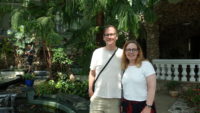 Sometimes travel is inefficient. Things take longer or wrong turns get made. That was me on Monday night when I somehow managed to miss the main drag in Palanga entirely, and took several wrong turns trying to get back to the hotel. It happens. Today was one of the days when several inefficiencies crept in. Good things still happened, but we had to keep at it and make some changes along the way.
Sometimes travel is inefficient. Things take longer or wrong turns get made. That was me on Monday night when I somehow managed to miss the main drag in Palanga entirely, and took several wrong turns trying to get back to the hotel. It happens. Today was one of the days when several inefficiencies crept in. Good things still happened, but we had to keep at it and make some changes along the way.
We slept in quite late for us on a European vacation (9:30) because we had been up so late last night. We got on the road to head a few miles north to what was, according to our guidebook, “a quiet fishing village.” It may have been a village, but it wasn’t quiet, and there was no fishing going on that I saw. The village has miles of beach, and everyone in the tri-Baltic area was on them today. I have no idea what the town is like on a nice Saturday.
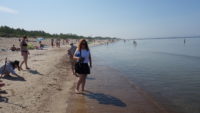 Because the word “village” implies “small,” Mer had thought we could drive up, park, walk to the beach, and see a thirteen-foot-high sculpture from the eighties called The Fisherman’s Daughters, which depicts three windswept daughters looking out to sea for their father. The artist’s niece said it represented the three Baltic states looking to the West to help them get out from under the Soviets. It’s an impressive work of art, or so we had been told.
Because the word “village” implies “small,” Mer had thought we could drive up, park, walk to the beach, and see a thirteen-foot-high sculpture from the eighties called The Fisherman’s Daughters, which depicts three windswept daughters looking out to sea for their father. The artist’s niece said it represented the three Baltic states looking to the West to help them get out from under the Soviets. It’s an impressive work of art, or so we had been told.
We never got to see it, sadly. We found parking and followed a steady stream of people through a line of shopping shacks set up along the road. We crossed a suspension bridge over a lagoon and walked over a boardwalk to the beach. We didn’t see any signs for the sculpture, so I looked it up on my phone. It was about a mile down the beach, which was crowded and sandy, as beaches often are. It would have taken at least an hour to walk there and back, and we had only paid for an hour of parking. So we walked along the Baltic Sea for a bit, and we both dipped our toes in. It was…how shall I say?…not warm.
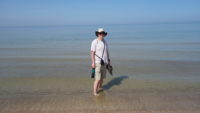 We figured we could drive to the sculpture, so we got in the car and drove south to where we could get to the beach again. There were cars everywhere and nowhere to park. We drove around for several minutes, but couldn’t read the signs about parking, so we didn’t know if they said something like “residents only.” We finally had to give up and move on to the next town. But we did see a fog-free sea and thousands of Lithuanians at play, so that was cheering.
We figured we could drive to the sculpture, so we got in the car and drove south to where we could get to the beach again. There were cars everywhere and nowhere to park. We drove around for several minutes, but couldn’t read the signs about parking, so we didn’t know if they said something like “residents only.” We finally had to give up and move on to the next town. But we did see a fog-free sea and thousands of Lithuanians at play, so that was cheering.
We went inland to the nearby town of Kretinga. We quickly found parking, and set off for Mer’s next destination, the Kretinga Museum. It turned out to be about a half-mile away because the GPS hadn’t recognized the exact address, so we set off on foot. Keep in mind that the day was quickly becoming the warmest day of our trip, topping out at around 86 degrees. We were fine, but going though our water quickly. When we got to the museum, they had parking across the street. Inefficiencies creep in.
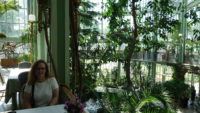 We hadn’t eaten breakfast or lunch yet, and it was 1:30 in the afternoon, so we bought museum tickets and beelined for the cafe. That was great. The museum is housed in a former mansion (the same family line who built a mansion in Palanga – this was an earlier family home), and the restaurant is housed in the former winter garden (an attached greenhouse). It was a soothing place to eat and drink and drink and drink. We polished off a whole pitcher of water with our extended meal.
We hadn’t eaten breakfast or lunch yet, and it was 1:30 in the afternoon, so we bought museum tickets and beelined for the cafe. That was great. The museum is housed in a former mansion (the same family line who built a mansion in Palanga – this was an earlier family home), and the restaurant is housed in the former winter garden (an attached greenhouse). It was a soothing place to eat and drink and drink and drink. We polished off a whole pitcher of water with our extended meal.
After lunchfast, we explored the museum, starting in the basement. That led us to the main floor of the winter garden and several exhibit rooms. There was a room dedicated to Lithuanian coins throughout the ages (I think it was a temporary exhibit). The other rooms were the same as in the Šiauliai museum – somehow summarizing history of the region from pre-history to around 1300 in four exhibits, none of which were in English, although it was laid out well enough that we could follow it. They managed to cram in one last room dedicated to the preservation and celebration of the Lithuanian language and culture.
 The second floor was a bit random. There was an exhibit on the history of communication in the area, with model telegraphs, a teletype, and several models of phones. There was finally a placard in English that explained that several counts installed telephones between their mansions just seven years after Bell invented the device, and that they used to allow people to come in to see how the phones worked. They were all one party line, so the caller had to blow in a special hole that transmitted a whistle to the whole system, so you had to have special codes for each person you were trying to reach. Mer got to take a simulated call on the model of the first telephone, but I don’t think the count on the other end was listening too well.
The second floor was a bit random. There was an exhibit on the history of communication in the area, with model telegraphs, a teletype, and several models of phones. There was finally a placard in English that explained that several counts installed telephones between their mansions just seven years after Bell invented the device, and that they used to allow people to come in to see how the phones worked. They were all one party line, so the caller had to blow in a special hole that transmitted a whistle to the whole system, so you had to have special codes for each person you were trying to reach. Mer got to take a simulated call on the model of the first telephone, but I don’t think the count on the other end was listening too well.
There were a few small displays on sports, including what looked to be motorbike soccer. There was a model of a couple of churches in the town, and many photos and portraits of the family, as well as early photos of the house.
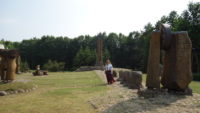 The third floor had furniture of the house (or from the mansion in Palanga), and multiple family trees. It seems as if the surviving line of the former counts consists of two brothers born in Los Angeles in the 1980s.
The third floor had furniture of the house (or from the mansion in Palanga), and multiple family trees. It seems as if the surviving line of the former counts consists of two brothers born in Los Angeles in the 1980s.
From the house, we walked out into the grounds, now a large park. There were no gardens like in Palanga, but the trees were all mature and huge. We wanted to find the astronomical calendar (that had been built by the count around 1900) as an excuse to see the park. We followed a sign that told us to go straight, so we did. The calendar was supposed to be three hundred meters down the path, so when we had gone five hundred or more, I looked it up on the phone. We were supposed to go straight down the path for about one hundred meters, and then fork off for the last part, but there had been no sign. Inefficiencies creep in again.
The calendar was cool, and must have existed to be cool since no one needed a sun calendar to tell them the date in 1900. The sun shines through a hole in a pillar, and where the shaft hits tells you one of several dates (like the solstices). I’m guessing it works at noon or some such, because the sun was well past the hole by 4:30.
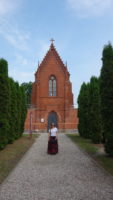 Some of the manor outbuildings were open as exhibits. One of them was a folk museum, showing how life was for farmers in the nineteenth and early twentieth centuries. They had masks and costumes and tools on display. I had two takeaways – life looked hard, even just 150 years ago, and the farming communities seemed to have a ton of superstition wrapped up in Christian dates and rituals. If you worked on certain saints’ days, you would have a bad crop, and so on. Bread was important – if you dropped a loaf, you had to pick it up and kiss it. If a child was sick, you laid him on top of a warm loaf of bread.
Some of the manor outbuildings were open as exhibits. One of them was a folk museum, showing how life was for farmers in the nineteenth and early twentieth centuries. They had masks and costumes and tools on display. I had two takeaways – life looked hard, even just 150 years ago, and the farming communities seemed to have a ton of superstition wrapped up in Christian dates and rituals. If you worked on certain saints’ days, you would have a bad crop, and so on. Bread was important – if you dropped a loaf, you had to pick it up and kiss it. If a child was sick, you laid him on top of a warm loaf of bread.
We finished the museum and took a look around the town, to go find a duplicate of the Lourdes Grotto. There was a cave made in a park, and copies of statues of St. Bernadette and of Mary were placed in it. It was a peaceful spot, with benches and a stream.
We walked up to the nearby Franciscan church to see it, passing a park along the way. This small town had the usual park – volleyball, basketball, soccer, workout equipment, full track, sand volleyball, and a playground. Lithuanians really seem to love their public spaces. The church was very pretty, and seemed to be decorated with some green vines inside, but we couldn’t investigate too closely because Mass was happening.
One last stop for the town – we checked out the cemetery we had parked across from. It had one of the prettiest brick chapels I have ever seen, which is where the local count and his family are buried. We couldn’t get in because it had just closed at 5:30. The church is built on a mound, so we were able to look around at the rest of the cemetery from there. Most of the gravestones looked to be newer – I’m not sure if they were replacements for Soviet-era headstones or not, but the entire space looked to be well taken care of. Many European cemeteries are crowded, with no space between graves, and this was one of those; in fact, it wasn’t clear that there was any available space left inside the walls of the courtyard. There was another cemetery across the street, so maybe that was a newer one.
 We drove back to Palanga, to our hotel, where Mer decided she couldn’t stand the fact that the hotel had an outdoor ping pong table and we hadn’t played. So, despite the warm evening, out we went. Admittedly, Mer had the poor end of the table – there was a glare on her side, and a woodpile on her left, and I think the table tiled up toward her, but nonetheless, for the first time in twenty-five-plus years, I beat Mer at ping-pong, 21-17. To reinforce my idea that there was a “good” side of the table, we switched sides, and Mer won the second game 21-18. But she is no longer undefeated. She thinks she may have been sluggish from the heat and all the walking, but she rallied plenty for the second game.
We drove back to Palanga, to our hotel, where Mer decided she couldn’t stand the fact that the hotel had an outdoor ping pong table and we hadn’t played. So, despite the warm evening, out we went. Admittedly, Mer had the poor end of the table – there was a glare on her side, and a woodpile on her left, and I think the table tiled up toward her, but nonetheless, for the first time in twenty-five-plus years, I beat Mer at ping-pong, 21-17. To reinforce my idea that there was a “good” side of the table, we switched sides, and Mer won the second game 21-18. But she is no longer undefeated. She thinks she may have been sluggish from the heat and all the walking, but she rallied plenty for the second game.
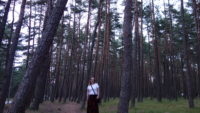 We took welcome advantage of the small but nice pool on the grounds. We were both hot and sticky from the day and the game, so a dip worked out well. After that, we walked back into town along the hike-and-bike trail and had supper on the quiet end of the strip, where we could people-watch. We finished up the night with a common experience for us – there was a Ferris wheel near the beach, and we rode it. It joined wheels we have ridden in Paris and London and Austria and Ireland. A walk back home along the now well-known path got us home at a leisurely but efficient pace.
We took welcome advantage of the small but nice pool on the grounds. We were both hot and sticky from the day and the game, so a dip worked out well. After that, we walked back into town along the hike-and-bike trail and had supper on the quiet end of the strip, where we could people-watch. We finished up the night with a common experience for us – there was a Ferris wheel near the beach, and we rode it. It joined wheels we have ridden in Paris and London and Austria and Ireland. A walk back home along the now well-known path got us home at a leisurely but efficient pace.
If it’s a replica of Lourdes, I suspect the figures are of St. Bernadette and Mary, not St. Barbara.
Right – I checked and did say St. Bernadette in the blog. My visual knowledge of saints is low, so I knew I had to get the name from somewhere. Thanks for reading! 🙂